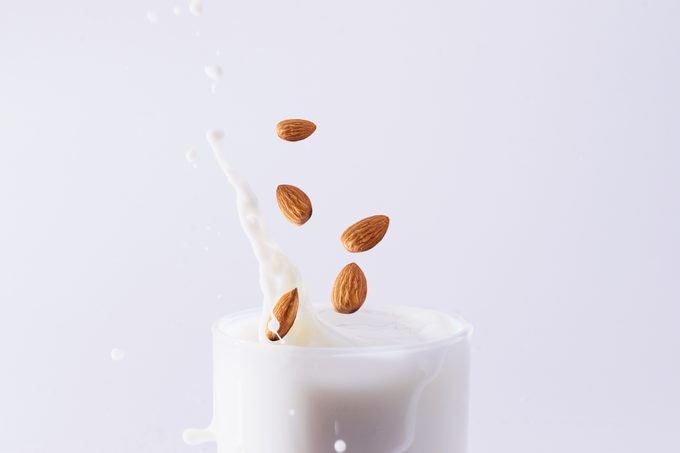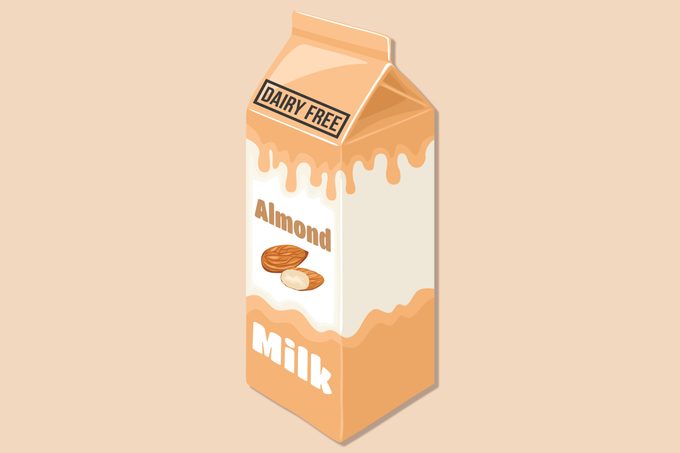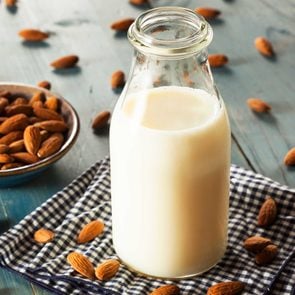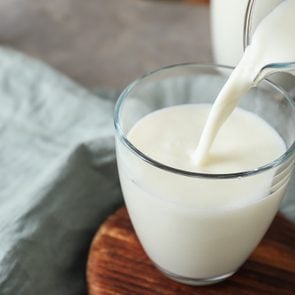Non-Dairy vs. Dairy-free: How One Woman Found Out the Difference
Updated: Nov. 10, 2020
Think dairy-free and non-dairy foods mean the same thing? Not at all. Food experts explain the difference and why you should always read the ingredients list.
Like most people, Mackenzie Williams loved ice cream as a child. But her reaction to it wasn’t so typical. “It was my absolute favorite indulgence, but eating it always gave me a stomach ache,” says Williams, who’s the photo editor at The Healthy. “It wasn’t until I was about 12 years old that I visited a nutritionist who told me I was most likely lactose intolerant. I knew she must be right.”
However, for years, she continued to eat dairy. “I decided to deal with the uncomfortable consequences,” she says. Finally, she initiated a long-overdue break-up with dairy. “As of two years ago, I decided enough was enough,” says Williams. “It was finally time to cut out milk and cream, as they hurt my stomach most out of all dairy products.” Then she removed even more dairy-containing foods from her diet.

Living in a dairy-filled world
Williams isn’t alone in her need to limit dairy: Lactose intolerance is common. About 65 percent of people have a lowered ability to digest lactose after their infant years, per the National Institutes of Health (NIH) U.S. National Library of Medicine.
And milk and dairy allergies are fairly prevalent. About 2 percent to 3 percent of children under age three have a milk allergy—about 20 percent of whom won’t outgrow this allergy by the time they reach age 16, according to the American College of Allergy, Asthma & Immunology.
A nasty “non-dairy” surprise
A year ago, Williams started drinking non-dairy, almond milk coffee creamer. “I was so excited about this because it tasted so good in my daily cup of coffee,” she says. But her body didn’t love it as much as her taste buds did.
About a month into her new creamer habit, Williams noticed tiny red dots on the tip of her nose, which over time spread to her cheeks. She saw a dermatologist, who prescribed several medicines. But her symptoms never fully resolved. In fact, her skin condition worsened, and her doctor feared it could be rosacea. At the same time, Williams was experiencing extreme gastrointestinal discomfort. “Every day, I felt extremely bloated and had ongoing stomach pain,” she notes.
Finally, she realized something in her coffee—her creamer—must be the culprit. “After inspecting the bottle, I realized it said ‘non-dairy,’ not ‘dairy-free,'” she says. That’s right. In the world of confusing food labels, the two descriptors can mean completely different things, and this can lead to other health issues, as Williams experienced firsthand. (Check out this healthy homemade creamer recipe you can customize to your own dietary needs.)
Food intolerance, allergy, and sensitivity
Just like non-dairy and dairy-free, these terms are not the same thing at all. And understanding the various reasons people may need to avoid, limit, or be careful about a food or ingredient is key to understanding what to look for on a label. (Find out what happens when you stop eating dairy.)
Food allergy
“An allergy directly involves the immune system,” explains Ginger Hultin, RD, a Seattle-based spokesperson for the Academy of Nutrition and Dietetics. “So if someone has an allergy to dairy proteins, her immune system is overreacting. This can cause symptoms such as itching, swelling, hives, and even a tight-feeling throat.”
A dairy allergy can potentially lead to truly serious and life-threatening symptoms, such as problems breathing or anaphylaxis—a severe, life-threatening allergic reaction.
Food intolerance
A lactose intolerance—by far, the most common type—is what plagues Williams. And while a food intolerance is rarely life-threatening, it can still be very unpleasant. “Lactose intolerance occurs when the body cannot digest the sugar in milk,” says Chrissy Carroll, RD, author of Dairy-Free Cookbook for Beginners and owner of the website Dairy Free for Baby. “When you have this condition, your body lacks enough of a specific enzyme called lactase, which is used to break down that sugar.” This may cause digestive problems like gas, bloating, and diarrhea—as well as other symptoms such as headache, fatigue, eczema, mouth ulcers, trouble urinating, and joint pain.
Food sensitivity
Finally, people can have a sensitivity to certain types of dairy. “Some literature refers to these types of reactions as a food hypersensitivity,” says Carroll. As with allergies, the reaction is to the protein in a food, but it’s not a reaction by the immune system. “These non-IgE [Immunoglobulin E] reactions include conditions that present in infancy, like food protein-induced enterocolitis syndrome or cow’s milk protein intolerance,” adds Carroll.
When you have a lactose intolerance, you may be able to tolerate certain lower-lactose foods such as butter or hard cheese. “Allergies, on the other hand, require complete elimination of all dairy products and ingredients,” notes Carroll. (Learn more about how to tell the difference between food allergies and food intolerances.)
The trick—after identifying your type of food issues—is to learn how to read the variety of labels you’ll find on the supermarket shelves.

“Non-dairy” doesn’t mean “no dairy”
The term “non-dairy” is regulated by the U.S. Food & Drug Administration (FDA)—but it may not mean what you think it does.
“Non-dairy products can still have milk protein like casein and whey,” says Hultin. “Both of these can cause allergic reactions.”
However, knowledge is power—and knowing how to investigate label claims is power, too. If a food contains a caseinate (dairy-based) ingredient, the FDA requires for its source to be listed in parentheses in the product’s ingredient list. So if a product were to list sodium caseinate on its ingredient list, for example, that ingredient might be followed by “a milk derivative” in parentheses. You may also see a “contains milk” statement on an ingredient label.
What non-dairy labeled foods can contain
As Williams learned, non-dairy products can contain milk proteins. “Non-dairy foods are concerning because historically many have contained caseinate ingredients,” says Carroll. “Always doublecheck labels on non-dairy products like creamers.” And how about lactose-free products? These are free of the sugar in milk, but they may still contain the milk protein. “These products are safe for people with lactose intolerance but unsafe for people with dairy allergies,” says Carroll.
Furthermore, the non-dairy label is not intended for use by people who have a milk or dairy allergy. Instead, it is meant for people who may consume a small amount of dairy or lactose. (However, many products labeled “non-dairy” are in fact dairy-free, notes the group GoDairyFree.)
The truth about dairy-free labels
Here’s some frustrating news for people who need to avoid dairy: The FDA doesn’t regulate the term “dairy-free,” so you can’t be sure of what you’re buying if you see a product with this descriptor. Unfortunately, you have no assurance that a dairy-free item doesn’t contain any milk proteins, notes the University of Nebraska-Lincoln Institute of Agriculture and Natural Resources.
Carroll notes that “while there is no regulatory definition for the term dairy-free on a package, the FDA warns against false or misleading labels. As such, food labeled dairy-free should be free of all dairy products. But a scan of the ingredients is always advised.”
If the ingredient list is confusing or unclear, you can always do a more thorough check. “If a food label says the item is manufactured in a facility that produces dairy, you might want to check with the manufacturer on its procedures before purchasing the item,” advises Tracee Yablon Brenner, RDN, in Nyack, New York. (See foods you think are dairy-free but aren’t.)

Waiting for a dairy-free label you can trust
The GoDairyFree group reached out to the FDA in 2019 to ask for a “dairy-free” label that consumers can rely on. The FDA responded: “We have interpreted the term ‘dairy-free’ as meaning the complete absence of all dairy ingredients including lactose, etc.” So it appears that the FDA’s intent is for dairy-free foods to truly be free of dairy and lactose-containing ingredients—but the lack of regulation means you’ll still have to check.
Always read the ingredients list
No matter whether you’re buying a dairy-free or non-dairy food, always read the ingredients list. “It is very important to read labels, as lactose may be in many processed foods,” says Brenner. Potential food sources include mixes like pancake mix, breakfast cereals, cereal bars, candy, creamer, frozen vegetables, noodle mixes, instant soup, rice potatoes, cheese-flavored crackers, and deli meat.
“There are obvious terms to look for like butter, buttermilk, cheese, cottage cheese, cream, curds, and ghee,” says Hultin. Then, there are less obvious ones like diacetyl, lactoferrin, lactulose, and rennet.”
What if you’re aiming to avoid just the majority of lactose? Look out for milk, cream, and soft cheeses. “Those are the foods highest in lactose,” says Kelly Jones, RD, a sports dietitian in Philadelphia. (Get flavorful dairy swap ideas.)
And if you take prescription medications, check the ingredients with the pharmacist. “About 20 percent contain lactose,” says Yablon Brenner. “These include birth control pills and medications for gas and stomach acid.”
Moving on from dairy
Williams has now given up cheese and butter—and shops very carefully for food. “I’ve noticed huge improvements with my skin,” she says. “About a week after cutting out the coffee creamer, my skin was clear. I can’t believe I was putting that coffee creamer into my body for a whole year without even realizing what it was doing to me.” (Get delicious vegan recipes for any time of day.)





















